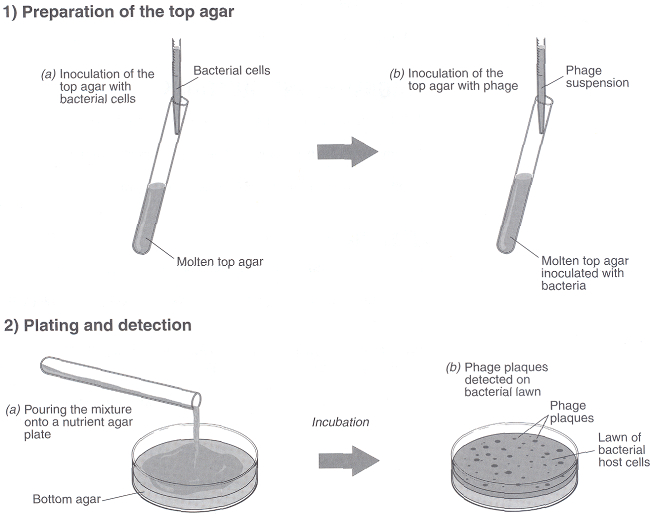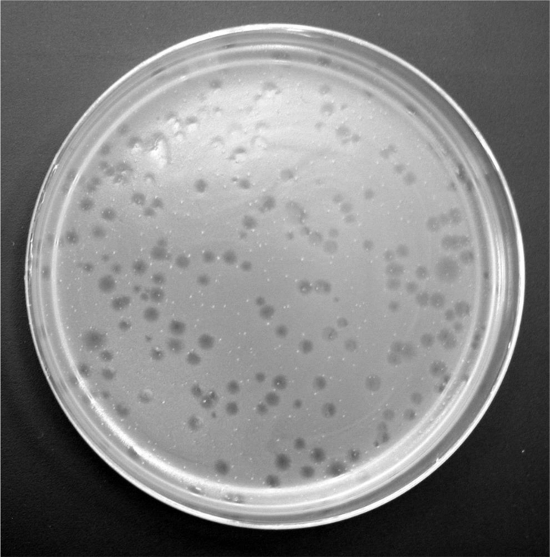Detection of Bacteriophages in Environmental Samples
Overview
Source: Laboratories of Dr. Ian Pepper and Dr. Charles Gerba - The University of Arizona
Demonstrating Author: Alex Wassimi
Viruses are a unique group of biological entities that infect both eukaryotic and prokaryotic organisms. They are obligate parasites that have no metabolic capacity, and in order to replicate, rely on host metabolism to produce viral parts that self-assemble inside host cells.
Viruses are ultramicroscopic—too small to be viewed with the light microscope, visible only with the greater resolution of the electron microscope. A viral particle consists of a nucleic acid genome, either DNA or RNA, surrounded by a protein coat, known as a capsid, composed of protein subunits or capsomers. In some more complex viruses, the capsid is surrounded by an additional lipid envelope, and some have spike-like surface appendages or tails.
Viruses that infect the intestinal tract of humans and animals are known as enteric viruses. They are excreted in feces and can be isolated from domestic wastewater. Viruses which infect bacteria are known as bacteriophages, and those which infect coliform bacteria are called coliphages (Figure 1). The phages of coliform bacteria are found anywhere coliform bacteria are found.

Figure 1. Coliphage T2.
Procedure
- Obtain a sample of sewage or water containing coliphage.
- Dilute the sample 1:10 and 1:100 using Tris buffer. Do this by transferring 1.0 mL of culture to 9 mL of Tris buffer, and then making a second 10-fold dilution.
- Melt three tubes of soft agar (0.7% nutrient agar or trypticase soy agar per 3 mL tube) by placing them in a steam bath or autoclave.
- Place the agar in a water bath at 45-48 °C for 15 min to allow the temperature of the agar to adjust to 45 °C.
- To the first tube, add 1 mL
Results
Dilution of sewage sample = 10-1
Number of plaques obtained = 9
Therefore, phage concentration in sewage sample
= 10 x 9 ÷ 1 mL
= 90 plaque-forming units / mL
Raw sewage typically contains 103 – 104 coliphage per mL, with a range of 102 – 108 per mL.
Application and Summary
There are many potential applications of coliphages as environmental indicators. These include their use as indicators of sewage contamination, efficiency of water and wastewater treatment, and survival of enteric viruses and bacteria in the environment. The use of bacteriophages as indicators of the presence and behavior of enteric bacteria and animal viruses has always been attractive because of the ease of detection and low cost associated with phage assays. In addition, they can be quantified in environmental samples
Tags
Skip to...
Videos from this collection:

Now Playing
Detection of Bacteriophages in Environmental Samples
Environmental Microbiology
40.7K Views

Determination of Moisture Content in Soil
Environmental Microbiology
359.2K Views

Aseptic Technique in Environmental Science
Environmental Microbiology
126.4K Views

Gram Staining of Bacteria from Environmental Sources
Environmental Microbiology
100.2K Views

Visualizing Soil Microorganisms via the Contact Slide Assay and Microscopy
Environmental Microbiology
42.2K Views

Filamentous Fungi
Environmental Microbiology
57.3K Views

Community DNA Extraction from Bacterial Colonies
Environmental Microbiology
28.8K Views

Detecting Environmental Microorganisms with the Polymerase Chain Reaction and Gel Electrophoresis
Environmental Microbiology
44.5K Views

RNA Analysis of Environmental Samples Using RT-PCR
Environmental Microbiology
40.4K Views

Quantifying Environmental Microorganisms and Viruses Using qPCR
Environmental Microbiology
47.8K Views

Water Quality Analysis via Indicator Organisms
Environmental Microbiology
29.5K Views

Isolation of Fecal Bacteria from Water Samples by Filtration
Environmental Microbiology
39.3K Views

Culturing and Enumerating Bacteria from Soil Samples
Environmental Microbiology
184.2K Views

Bacterial Growth Curve Analysis and its Environmental Applications
Environmental Microbiology
295.9K Views

Algae Enumeration via Culturable Methodology
Environmental Microbiology
13.8K Views
Copyright © 2025 MyJoVE Corporation. All rights reserved

